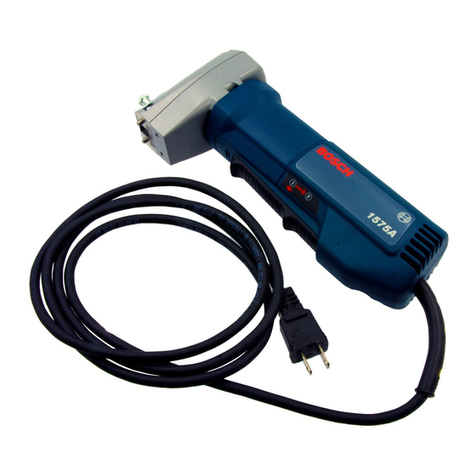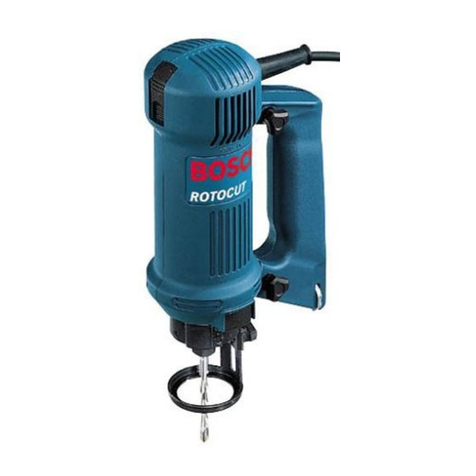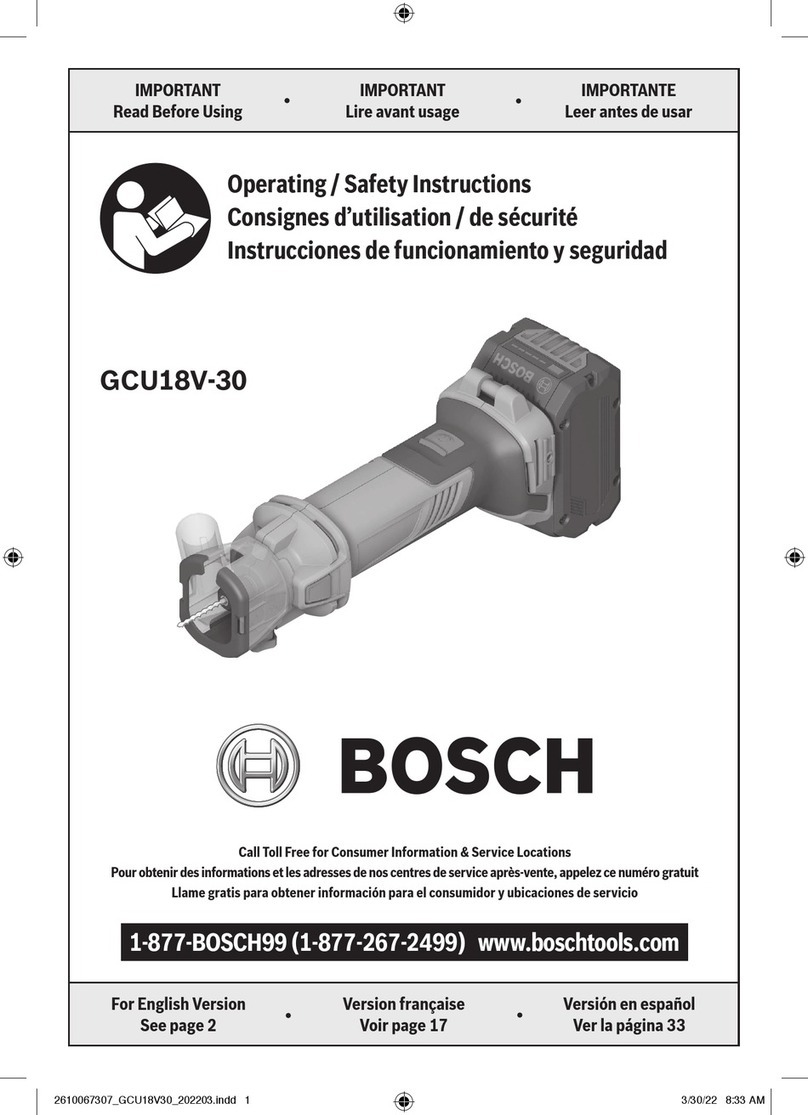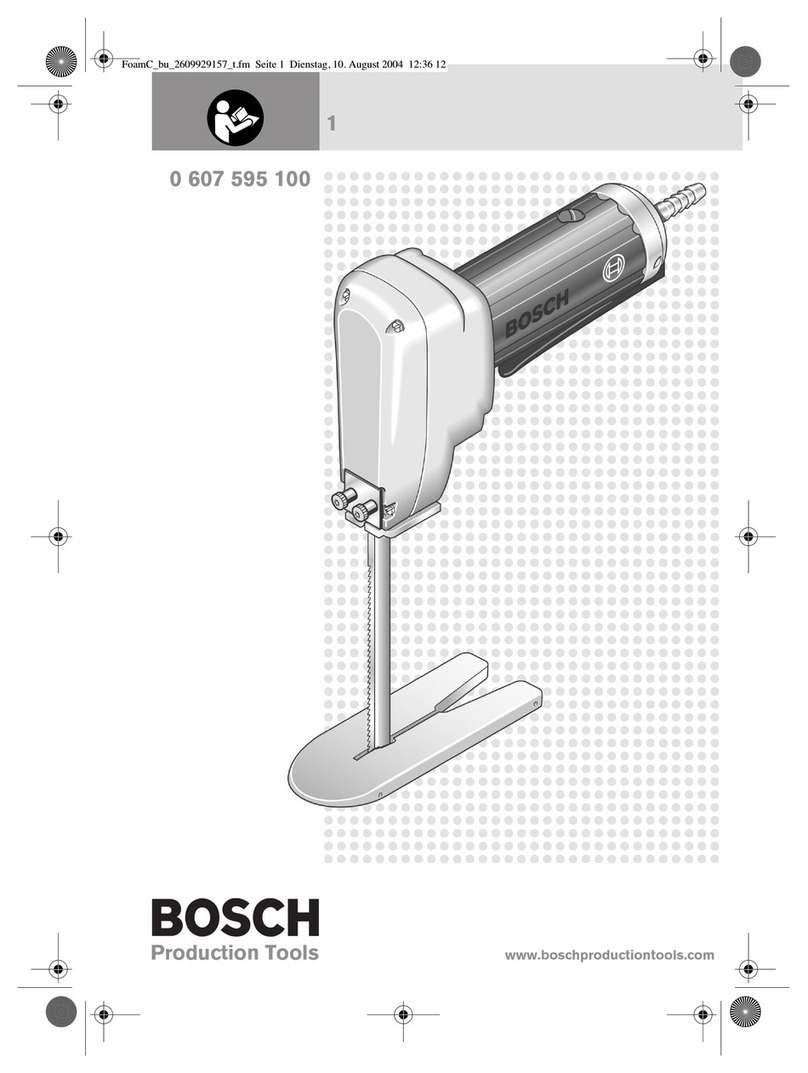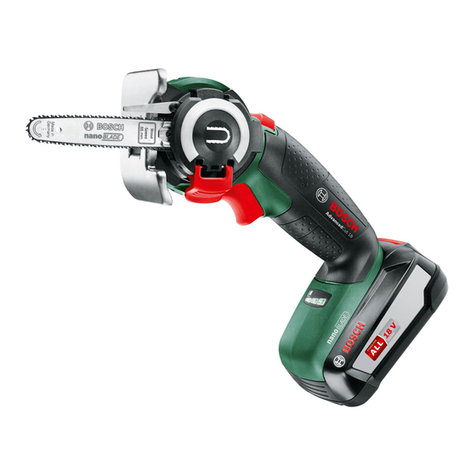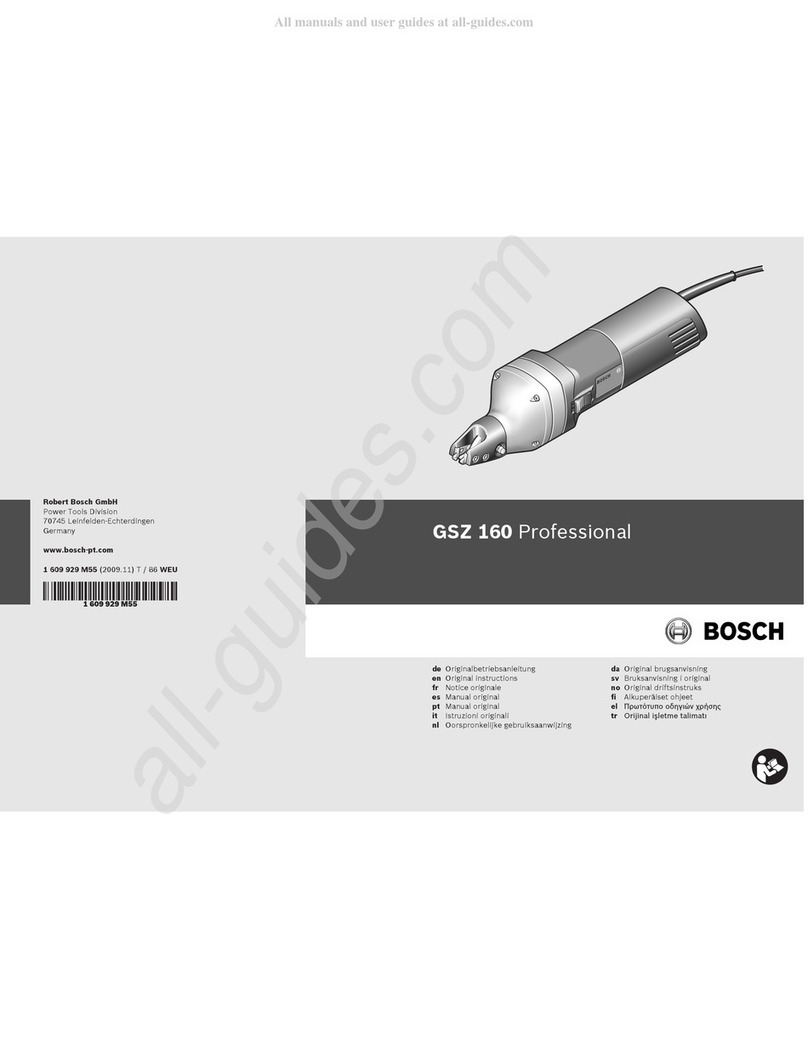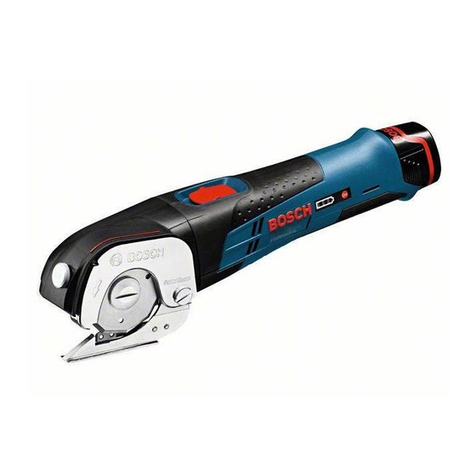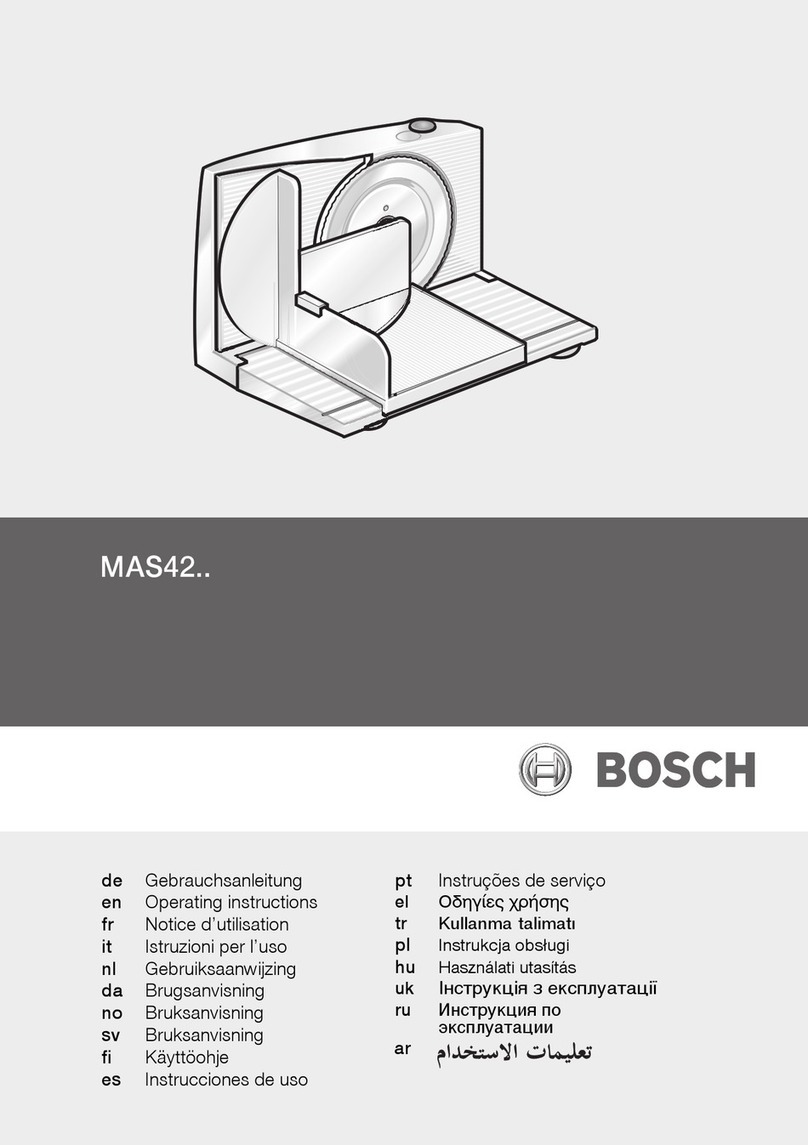6| Deutsch
2 609 932 802 | (14.2.12) Bosch Power Tools
Deutsch
Sicherheitshinweise
Allgemeine Sicherheitshinweise für Elektro-
werkzeuge
Lesen Sie alle Sicherheitshinweise
und Anweisungen. Versäumnisse bei
der Einhaltung der Sicherheitshinweise und Anweisungen
können elektrischen Schlag, Brand und/oder schwere Ver-
letzungen verursachen.
Bewahren Sie alle Sicherheitshinweise und Anweisungen
für die Zukunft auf.
Der in den Sicherheitshinweisen verwendete Begriff „Elektro-
werkzeug“ bezieht sich auf netzbetriebene Elektrowerkzeuge
(mit Netzkabel) und auf akkubetriebene Elektrowerkzeuge
(ohne Netzkabel).
Arbeitsplatzsicherheit
fHalten Sie Ihren Arbeitsbereich sauber und gut be-
leuchtet.Unordnung oderunbeleuchteteArbeitsbereiche
können zu Unfällen führen.
fArbeiten Sie mit dem Elektrowerkzeug nicht in explosi-
onsgefährdeter Umgebung, in der sich brennbare Flüs-
sigkeiten,GaseoderStäubebefinden.Elektrowerkzeuge
erzeugen Funken, die den Staub oder die Dämpfe entzün-
den können.
fHalten Sie Kinder und andere Personen während der
Benutzung des Elektrowerkzeugs fern. Bei Ablenkung
können Sie die Kontrolle über das Gerät verlieren.
Elektrische Sicherheit
fDer Anschlussstecker des Elektrowerkzeuges muss in
dieSteckdosepassen.DerSteckerdarfinkeinerWeise
verändert werden. Verwenden Sie keine Adapterste-
cker gemeinsam mit schutzgeerdeten Elektrowerkzeu-
gen.Unveränderte Stecker und passende Steckdosen ver-
ringern das Risiko eines elektrischen Schlages.
fVermeiden Sie Körperkontakt mit geerdeten Oberflä-
chen wie von Rohren, Heizungen, Herden und Kühl-
schränken. Es besteht ein erhöhtes Risiko durch elektri-
schen Schlag, wenn Ihr Körper geerdet ist.
fHalten Sie Elektrowerkzeuge von Regen oder Nässe
fern. Das Eindringen von Wasser in ein Elektrowerkzeug
erhöht das Risiko eines elektrischen Schlages.
fZweckentfremden Sie das Kabel nicht, um das Elektro-
werkzeugzu tragen, aufzuhängenoderum den Stecker
aus der Steckdose zu ziehen. Halten Sie das Kabel fern
von Hitze, Öl, scharfen Kanten oder sich bewegenden
Geräteteilen. Beschädigte oder verwickelte Kabel erhö-
hen das Risiko eines elektrischen Schlages.
fWenn Sie mit einem Elektrowerkzeug im Freien arbei-
ten, verwenden Sie nur Verlängerungskabel, die auch
für den Außenbereich geeignet sind. Die Anwendung
eines für den Außenbereich geeigneten Verlängerungska-
bels verringert das Risiko eines elektrischen Schlages.
fWenn der Betrieb des Elektrowerkzeuges in feuchter
Umgebung nicht vermeidbar ist, verwenden Sie einen
Fehlerstromschutzschalter. Der Einsatz eines Fehler-
stromschutzschalters vermindert das Risiko eines elektri-
schen Schlages.
Sicherheit von Personen
fSeien Sie aufmerksam, achten Sie darauf, was Sie tun,
und gehen Sie mit Vernunft an die Arbeit mit einem
Elektrowerkzeug. Benutzen Sie kein Elektrowerkzeug,
wenn Sie müde sind oder unter dem Einfluss von Dro-
gen, Alkohol oder Medikamenten stehen. Ein Moment
derUnachtsamkeitbeimGebrauchdesElektrowerkzeuges
kann zu ernsthaften Verletzungen führen.
fTragen Sie persönliche Schutzausrüstung und immer
eine Schutzbrille. Das Tragen persönlicher Schutzausrüs-
tung, wie Staubmaske, rutschfeste Sicherheitsschuhe,
Schutzhelm oder Gehörschutz, je nach Art und Einsatz des
Elektrowerkzeuges, verringert das Risiko von Verletzungen.
fVermeiden Sie eine unbeabsichtigte Inbetriebnahme.
Vergewissern Sie sich, dass das Elektrowerkzeug aus-
geschaltet ist, bevor Sie es an die Stromversorgung
und/oder den Akku anschließen, es aufnehmen oder
tragen.WennSie beimTragendes Elektrowerkzeugesden
Finger am Schalter haben oder das Gerät eingeschaltet an
die Stromversorgung anschließen, kann dies zu Unfällen
führen.
fEntfernen Sie Einstellwerkzeuge oder Schrauben-
schlüssel, bevor Sie das Elektrowerkzeug einschalten.
EinWerkzeug oder Schlüssel, der sich in einemdrehenden
Geräteteil befindet, kann zu Verletzungen führen.
fVermeiden Sie eine abnormale Körperhaltung. Sorgen
Sie für einen sicheren Stand und halten Sie jederzeit
das Gleichgewicht. Dadurch können Sie das Elektrowerk-
zeug in unerwarteten Situationen besser kontrollieren.
fTragen Sie geeignete Kleidung. Tragen Sie keine weite
Kleidung oder Schmuck. Halten Sie Haare, Kleidung
und Handschuhe fern von sich bewegenden Teilen.
Lockere Kleidung, Schmuck oder lange Haare können von
sich bewegenden Teilen erfasst werden.
fWenn Staubabsaug- und -auffangeinrichtungen mon-
tiertwerden können, vergewissernSie sich, dass diese
angeschlossen sind und richtigverwendet werden. Ver-
wendung einer Staubabsaugung kann Gefährdungen
durch Staub verringern.
Verwendung und Behandlung des Elektrowerkzeuges
fÜberlasten Sie das Gerät nicht. Verwenden Sie für Ihre
Arbeit das dafür bestimmte Elektrowerkzeug. Mit dem
passenden Elektrowerkzeug arbeiten Sie besser und
sicherer im angegebenen Leistungsbereich.
fBenutzenSiekeinElektrowerkzeug,dessen Schalter de-
fekt ist. Ein Elektrowerkzeug, das sich nicht mehr ein- oder
ausschalten lässt, ist gefährlich und muss repariert werden.
fZiehen Sie den Stecker aus der Steckdose und/oder
entfernenSiedenAkku,bevorSieGeräteeinstellungen
vornehmen, Zubehörteile wechseln oder das Gerät
weglegen. Diese Vorsichtsmaßnahme verhindert den
unbeabsichtigten Start des Elektrowerkzeuges.
WARNUNG
OBJ_BUCH-1271-004.book Page 6 Tuesday, February 14, 2012 11:38 AM


